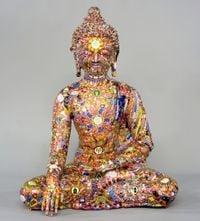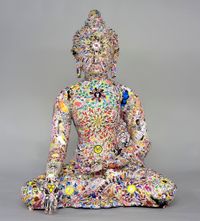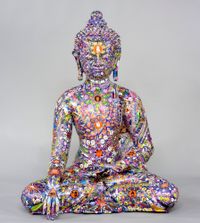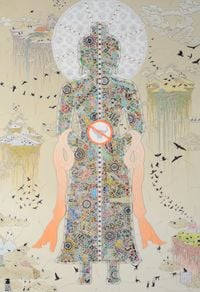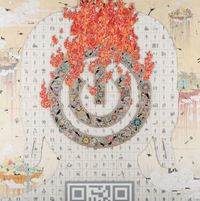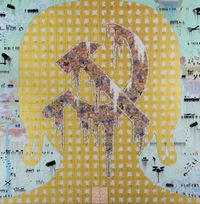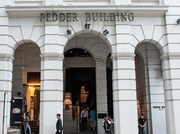Gonkar Gyatso is known for his colourful collages of found stickers, logos and images that irreverently merge popular culture's iconography with symbols of Buddhist spiritualism. Working across collage, photography, painting and installation, his work charts the ways identities shift in relation to globalisation and migration. Playfully subverting stereotypes of Tibetan culture while reflecting on the popularity of commercial Buddhism in the West, Gyatso considers the hybrid condition of living between cultures.
Read MoreBorn in 1961 in Lhasa, Tibet, Gyatso was the son of a Peoples Liberation Army soldier during the Chinese Cultural Revolution, which saw widespread censorship of art forms that did not adhere to a strict ideological programme. In his early 20s, Gyatso studied traditional Chinese brush painting in Beijing. Following his studies, he decided to travel to Dharamshala, India, to learn thangka—a traditional style of Tibetan painting. This became a turning point for his practice as he began to engage with themes of identity and cultural shapeshifting. In 1984, he moved back to Tibet where he founded the first iteration of Sweet Tea House—the first Tibetan avantgarde artists' association—in Lhasa.
In 1996, Gyatso moved to London on a scholarship to study fine art at Chelsea College of Arts. His subsequent engagement with the city and its art world expanded his focus beyond Tibet-China relations to engage with broader issues like global capitalism, excess and the human impacts of war. In 2003, he established Sweet Tea House in London as a space to present contemporary Tibetan art. In the same year, Gyatso received a Leverhelm Fellowship and undertook a residency at Pitt Rivers Museum in Oxford.
One of Gyatso's first photographic series, 'My Identity' (2003), depicts the artist across four different periods of his life, from a traditional Tibetan artist to an artist in exile in London. In each photograph, the artist is pictured painting in a different style according to his cultural and geographic location—from traditional Tibetan thangka to modern abstraction.
In 2004, Gyatso's practice took a radical turn as he began to experiment with collage and new forms of visual language. In The religion question (2004), Gyatso used quotations from Mao Zedong to make up the figure of the Buddha. From there, collage and popular culture became key elements of his practice. The series 'Tibetan Idol' (2006) depicts the Buddha rendered from stickers of cartoons, corporate logos, Chinese characters and other facets of the everyday world and popular culture.
By 2007, Gyatso had become recognised for his stickered collages. At the same time, he was becoming more concerned with politics, particularly the Iraq War. His most strikingly political work, Angel (2007), transforms the sitting Buddha into the figure of a tortured Abu Ghraib prisoner. The image of the prisoner is appropriated from the now-iconic media image of a hooded prisoner wired to an electric-shock torture device. Angel reveals the extent of abuse by United States soldiers and seeks to comfort the figure by placing him in front of the Buddhist deity of compassion.
Gyatso participated in Making Worlds—the 53rd Venice Biennale (2009)—with one of his most recognised works, The Shambala in Modern Times (2008), which depicts the Buddha surrounded by the halo of traditional Tibetan thangka. The reproduction and re-appropriation of the Buddha has continued to play out through Gyatso's practice, transforming the figure of the Buddha into three-dimensional sculptures clad in his signature sticker collage.
Gyatso has returned to photography and self-portraiture in recent years, exploring identity and hybridity through himself and the people close to him. He was included in the Encounters sector at Art Basel in Hong Kong (2017) where he presented the installation Family Album, in which life size cut-outs showed members of his own family clothed in both traditional and modern dress, revealing the complexity of identity in contemporary Tibetan culture.
Elyse Goldfinch | Ocula | 2018
